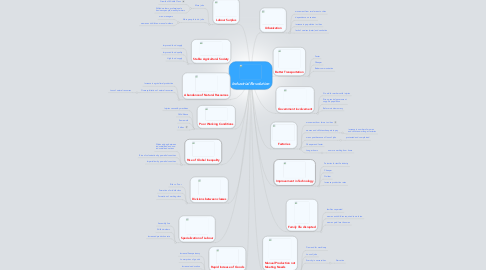Industrial Revolution
by Ilia Jauharis


1. Stable Agricultural Society
1.1. Improved food supply
1.2. Improved food quality
1.3. High food supply
2. Labour Surplus
2.1. More jobs
2.1.1. Growth of Middle Class
2.1.2. Skilled workers, professionals, business people, wealthy farmers
2.2. More people to do jobs
2.2.1. men- managers
2.2.2. women and children- manual workers
3. Abundance of Natural Resources
3.1. Increase in agricultural production
3.2. Overexploitation of natural resources
3.2.1. Loss of natural resources
4. Poor Working Conditions
4.1. Injuries caused by machines
4.2. Child Abuse
4.3. Same work
4.4. Strikes
5. Rise of Global Inequality
5.1. Widened gap between industrialized and non- industrialized nations
5.2. Rise of colonization by powerful countries
5.3. Imperialism by powerful countries
6. Divisions between classes
6.1. Rich vs. Poor
6.2. Formation of middle class
6.3. Formation of working class
7. Specialization of Labour
7.1. Assembly line
7.2. Skilled workers
7.3. Increased production rate
8. Rapid Increase of Goods
8.1. Increase life expectancy
8.2. Lower prices of goods
8.3. Increase in education
9. Urbanization
9.1. movement from rural areas to cities
9.2. dependance on services
9.3. increase in population in cities
9.4. lack of services (water) and sanitation
10. Better Transportation
10.1. Faster
10.2. Cheaper
10.3. Better communication
11. Government involvement
11.1. No aid for workers with injuries
11.2. Strong central government support population
11.3. Reforms in democracy
12. Factories
12.1. movement from farms to cities
12.2. women and children cheapest to pay
12.2.1. increase in number of women and children working at factories
12.3. men upset because of loss of jobs
12.3.1. protested and complained
12.4. Cheaper and faster
12.5. Longer hours
12.5.1. no more working from home
13. Improvement in Technology
13.1. Factories for textile industry
13.2. Cheaper
13.3. Quicker
13.4. Increase production rates
14. Family life disrupted
14.1. families separated
14.2. women and children required to work too
14.3. women paid less than men
15. Manual Production not Meeting Needs
15.1. Demand for machinery
15.2. Loss of jobs
15.3. Scarcity in neccessities
15.3.1. Starvation
